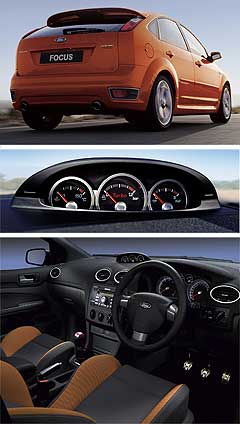First drive: Ford's fabulous new Focus XR5 Turbo
BY BYRON MATHIOUDAKIS | 28th Apr 2006

Engineered and built in Germany (at Ford’s Saarlouis plant), the Focus XR5 Turbo – known as the ST overseas – is on sale now at $35,990 plus on-roads for the sole five-door hatchback body style.
Driving the front wheels via a six-speed manual-only gearbox is a transversely mounted 2.5-litre turbocharged in-line five-cylinder twin-cam 20-valve Volvo engine delivering 166kW of power and 320Nm of torque.
And although the former’s peak output occurs at a heady 6000rpm, the latter’s comes in between 1600rpm and 4000rpm.
Much of that is the result of the Kühnle, Kausch and Kopp-Warner KKK K04-2080 D integrated turbocharger – a low-blow unit providing 0.65 bar of pressure (or 9.5 pounds per square inch, imperially speaking).
Ford says that this, along with the engine’s undersquare design due to its narrow bore (83mm) and long stroke (93mm), makes it an unstressed unit compared to some of its more highly-strung competitors. The company’s European high-performance arm – Ford TeamRS, set out to exceed 150kW for the vehicle it created to conquer the 147kW/280Nm VW Golf GTI, 165kW/300Nm Renault Megane 225 Sport Cup and HSV's forthcoming 176kW/320Nm Astra VXR.
To that end Ford also performed a host of structural and mechanical upgrades.
Beginning with the LS Focus body (which is already 30 per cent stiffer than the previous-generation LR original), a cross-member has been added across the bulkhead.
Ford says it has maintained the regular Focus’ suspension fundamentals, electing instead to refine it by adding a stiffer new front subframe.
The front and rear springs are 30 per cent stiffer, while the anti-roll bar is five per cent thicker.
The ‘Control Blade’ independent rear suspension receives stiffer rubber housings for the lower control arms, while the axle geometry is modified to handle higher lateral forces.

It does, however, incorporate a quicker and more direct variable turning ratio for eight per cent faster-acting steering compared to the rest of the LS Focus range.
One innovation here is a three-mode computer-controlled electric steering pump that can be driver-adjusted to increase or decrease boost for ‘comfort’, ‘normal’ or ‘sporty’ levels. Upgraded brakes are also part of the package – going to 320mm from 278mm ventilated discs at the front (activated by new four-piston brake callipers) and 280mm from 260mm in diameter for the discs out back, controlled via a two-piston calliper arrangement.
TeamRS also chose specially tuned 225/40 R18 tyres, while the XR5 is the only LS Focus to offer stability control, known as DSC in Ford-speak, working in unison with the four anti-lock brake sensors, a steering sensor and a centrally mounted yaw sensor.
Ford Australia says it will consider offering this potentially life-saving option further down the Focus range if there’s a customer demand for it. Hyundai already does in its $14,490 Getz 1.6.
Another safety upgrade going XR5 gives you are side curtain airbags – since the South African plant that the more mundane Focuses are made in does not seem to have the ability to implement them. A fix is coming soon here, apparently.
A new twin-exhaust outlet, featuring a much larger muffler, has been devised for improved throughput efficiency and increased aural pleasure. However, since it partly nestles where the full-sized spare wheel would normally live – under the boot floor – a space-saver must suffice, sited above the muffler, leading to somewhat reduced luggage space. The specially designed lower rear-bumper treatment gives the game away, with its two large round exhaust pipes that are flanked by aluminium-trimmed rectangular fog and reverse light surrounds and rear wheelarch spats.
You’ll also pick the hefty 1437kg XR5 Turbo from its more mundane Focus family members by its rear roof spoiler, subtle bodykit featuring lower-sill mouldings, kaleidoscope-style 18-inch five-spoke alloy wheels, and side mirror indicator flashers (moved from the upper front mudguards).
Moving to the front there’s a reshaped mesh grille (it’s larger and taller than the regular car’s) forming part of a completely redesigned bumper that also houses aluminium-trimmed rectangular foglight trim surrounds, and a much larger lower mesh air intake.
Inside there is a very 1960s fast-Ford three-dial (oil temperature, oil pressure and turbo boost) instrument pod sited above the dashboard and angled towards the driver rally-car style, complementing the revised main-binnacle graphics.
There’s aluminium accents everywhere, including on the dash, lower console and doors, alloy pedals, a new three-spoke leather trimmed steering wheel, an integrated Sony eight-speaker sound system, and Recaro cloth front seats with matching colour door-trim inserts, among other goodies. For $2000 extra heated leather Recaro front seats can be fitted, while the three-person rear bench is turfed for a sculptured Recaro two-seat set-up.
The only other option is the $1800 orange hero hue, which requires a long and complicated painting process. Red is the only non-metallic colour.
Ford is counting on selling around 40 XR5 Turbos each month. Supply here is limited by heavy demand in Europe.